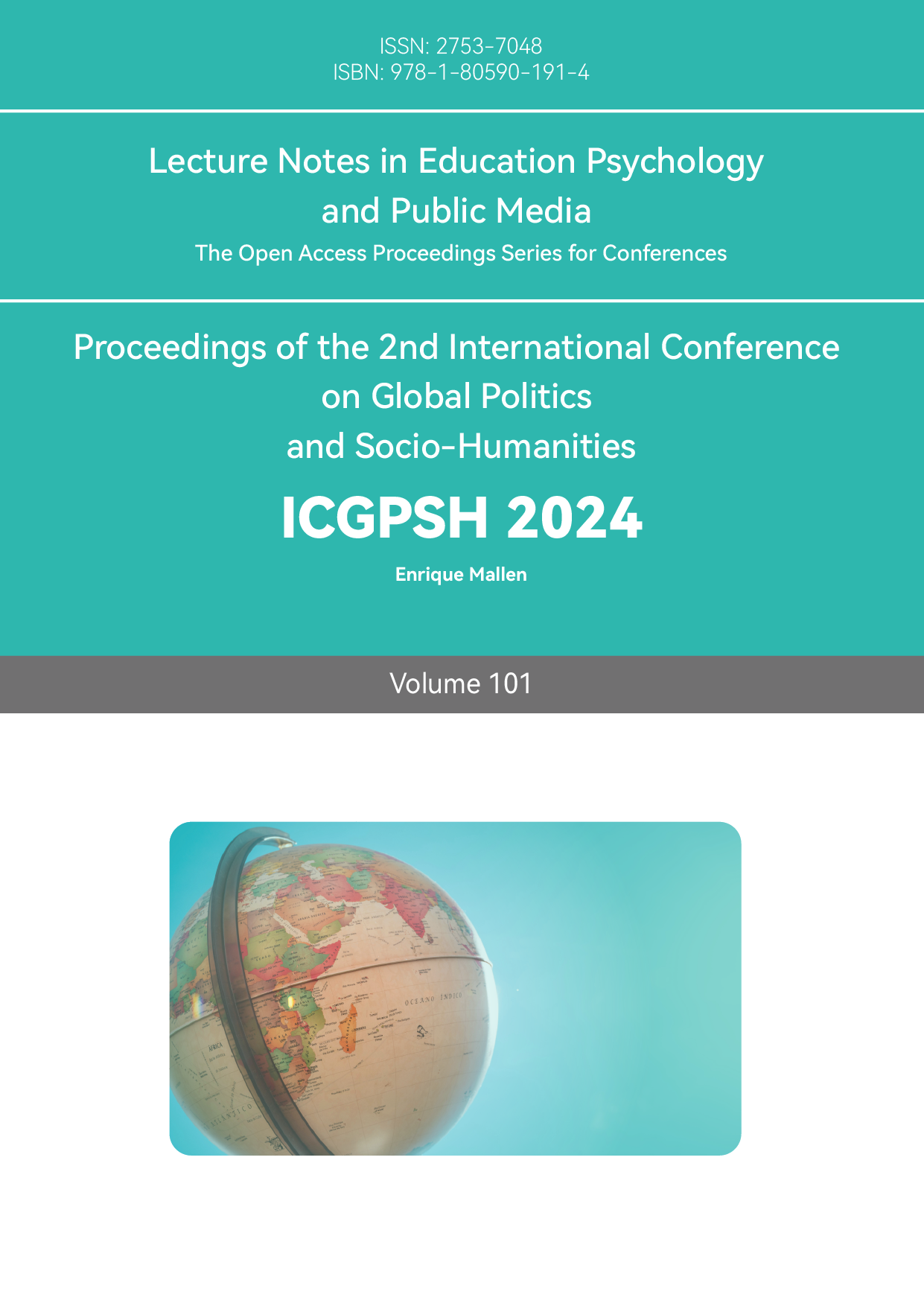1. Introduction
There is a huge amount of literature on the impact of family planning policy in China (including the one-child policy, two-child policy, and three-child policy). Many authors have pointed out the relationship between family planning policy and population growth, economic development, and resource and environmental sustainability [1]. China's family planning policies, especially the one-child policy implemented in 1979, have dramatically changed the country's demographic and economic dynamics, with long-term consequences for the demographic structure and differential impacts on labor supply and productivity in urban and rural areas. Lai showed that in a heterogeneous society like China, especially when urban and rural areas are divided, a unified birth control policy will exacerbate urban and rural income inequality [2]. The resulting impact has drawn widespread attention to China's urban-rural income inequality, with relevant academic research focusing mainly on education levels and social causes. For example, Xie and Zhou claimed that family education level can explain about 15% of income inequality [3]. In addition to education, different occupation types can also increase income inequality between urban and rural areas [4]. However, little literature has focused on the impact of family planning policy on the urban-rural income gap. According to our research, Family planning policies have different impacts on the income of rural and urban residents. For example, Yu et al. claimed that China's one-child policy (OCP) has exacerbated economic inequality across generations in China [5].Rural Chinese families, whose fertility choices are less constrained by the OCP than those of wealthier families in the city, have more children but invest less in the human capital of each child. Since human capital is the main determinant of income, income inequality persists and subsequently widens.
In this paper, we will analyze the impact of the urban-rural income gap due to the one-child policy by means of a literature review and the impact of the two- and three-child policies on the income gap between urban and rural residents by means of data. For the impact of the two and three-child policy, we will use a multiple regression model to analyze the extent to which the urban and rural birth rate (with respect to the fertility policy), as well as the urban and rural migration rate, affect the urban-rural income gap.
Based on multiple regression modeling, the findings of this paper suggest that family planning policies affect urban-rural income inequality. More specifically, relatively liberal family planning policies (i.e., two- and three-child policies) narrow the income gap between urban and rural areas. The regression analysis shows that the effect of migration on urban-rural income inequality is negligible, which is evidence of the greater impact of the birth rate gap on the urban-rural income distribution.
The remainder of the paper is organized as follows: Section 2 presents the literature review. We introduce the background of family planning policy and review some of the literature that contributed to this paper. Section 3 discusses the impact of the one-child policy on urban-rural income disparity. Section 4 explains the methodology and data presentation. In section 5, we use the linear regression models to find the relationship between changes in the urban-rural income gap and birth and internal migration rates by region. Section 6 concludes.
2. Literature review
2.1. Background of family planning policy
Wang suggests that in the early 1970s, birth rates remained high [6]. Concerned about the social and economic consequences of continued rapid population growth, China initiated a nationwide family planning program in 1973 to provide birth control methods and family planning services. Contraceptive and abortion services were extended to rural areas, and late marriage, longer birth intervals and small families were widely promoted. Subsequently, in response to aging and labor shortages, China relaxed its one-child policy in 2013, allowing couples to have two children if they meet the conditions. This adjustment was intended to boost population growth. State Council (PRC). officially implemented a comprehensive two-child policy, allowing all couples to have two children [7]. This policy is aimed at easing the aging problem and increasing the labor supply. With the challenge of continued fertility decline, China announced in 2021 that it would allow three children per couple, aiming to increase fertility intentions [8].
Overall, China's fertility policy has undergone a series of changes from strict control to gradual liberalization, with significant demographic changes. Because of demographic changes, the number of people of working age has changed. Many researchers have found that fertility policies have different effects in different regions, which affects the accumulation of human capital in urban and rural areas, which in turn leads to the urban-rural income gap.
2.2. Existing literature on income inequality
Li, et al. emphasize that although China has experienced significant economic growth since the late 20th century, this growth has been accompanied by a huge increase in income inequality [9]. The authors trace the roots of this inequality to historical and structural factors, including disparities in regional development, education, and access to economic opportunity. These factors jointly affect the distribution of social wealth and hence increase the differences in the economic status of different social groups.
When exploring the causes of income inequality, Wu and Su further analyzed the impact of specific policies in China, especially the one-child policy, on the income gap between urban and rural populations [10]. They use empirical data from CFPS to analyze how these policies affect income distribution in different geographic regions. Their research aims to quantify the relationship between family planning measures and income inequality, providing insights into the broader socioeconomic impact of such policies.
Thus, while Li, Terry, and Finn discovered various factors in income inequality, Wu and Su's study highlights the specific role that certain policies (such as the one-child policy) play in exacerbating or ameliorating such inequality. It provides an important perspective for us to understand the complex relationship between China's economic growth and income inequality more comprehensively.
There are also further studies such as Lai did, which revealed the different impacts of family planning policy on urban and rural areas [2]. Urban areas have better access to health care, education, and social services and are able to adapt more effectively to and benefit from family planning policies. In contrast, rural areas face challenges due to limited access to similar resources, which exacerbates existing income disparities. This observation is consistent with the findings of Li and Zhao [11]. They used a large amount of empirical data to conduct an in-depth analysis of the income distribution of Chinese residents. Through statistics and comparison of income data across the country, the book describes in detail the income gaps and changes in different regions and social groups. These data not only reveal the inequality of income distribution but also analyze the specific factors leading to this phenomenon, such as economic structural adjustment, urban-rural gap, education level, etc. By combining these studies, we can gain a more complete understanding of the intricate relationships between economic policy, social structure, and income inequality.
3. The impact of one-child policy on urban-rural income disparity
China’s one-child policy, which is the family planning policy enacted from 1979 to 2015, has had many impacts from different aspects on the overall income gap between urban and rural areas. Firstly, the one-child policy reduced the labor supply within the whole country. The specific policy reduces the birth rate, thereby reducing future labor supply. This may lead to an increase in urban labor costs in the short term, as reduced supply makes workers relatively scarce and companies need to pay higher wages to attract or retain employees. Moreover, urban labor markets are more sensitive to wages, so policies that reduce labor supply may push up wages in urban areas. At the same time, the labor market in rural areas may face low wage levels due to attrition or migration and hence exacerbate the urban-rural income gap. In the long run, the reduction in labor supply may inhibit economic growth, especially in labor-intensive industries. The growth of the urban economy may be affected, thus slowing the improvement of urban incomes, while the rural economy may be more vulnerable due to insufficient labor.
Secondly, the implementation of the one-child policy will lead to a greater concentration of education resources. This policy encourages families to invest more in the education of their only child. Urban families generally have more resources and opportunities to provide high-quality education and extracurricular activities, which can help their children to improve their future earning potential and social status. High-income families in cities can invest in private schools, institutions and other educational resources to enhance their children’s competitiveness. By contrast, rural families face more challenges in investing in education; due to limited economic conditions, rural families are unable to provide the same level of educational resources, and school facilities and education quality are generally low. This inequality in educational resources leads to limited opportunities for rural children, thereby limiting their future income growth opportunities. The education gap between urban and rural areas has become more pronounced with the implementation and duration of the one-child policy. Urban families' investment in their only children can significantly improve their career prospects and income levels. However, due to insufficient resources, rural families' children's education levels improve more slowly, and their career opportunities are more limited. By investing intensively in education, urban families can create better career opportunities for their children, thereby increasing the overall wealth level of the family. However, due to the lack of educational resources in rural families, their children may have low income levels, and intergenerational wealth accumulation may be restricted.
Thirdly, the one-child policy accelerated the aging of the population. It has led to a decline in the birth rate, and the problem of population aging has gradually emerged. Due to rapid economic development in urban areas, the pension security system is relatively complete, and the elderly can usually enjoy more social welfare and medical security. Whereas the elderly in rural areas face fewer pension resources and welfare support. As Lai claimed in urban areas, a person can receive varying amounts of pensions from enterprises or society after retirement and can basically become financially independent [2]. In rural areas, elderly care is mainly the mission of the family. When a person is too old to support himself, he must rely on the care of his children. There are basically no institutional arrangements for social security. Even if there are, they are only partial and in a short-supply state. This led to the gap in living standards between urban and rural elderly people. In addition, children in urban areas usually don't have to worry too much about their parents' life problems. However, in rural areas, children often need to take more family burdens, including supporting the elderly and bearing living expenses, which increases the economic pressure on rural families and may further affect their overall economic status. Aging can lead to intergenerational inequality as well. In cities, the younger generation is better off financially as they have better access to education and career opportunities. In rural areas, the income levels of the younger generation are lower due to limited educational and career opportunities.
Lastly, China accelerated economic reform and urbanization during the implementation of the one-child policy [12]. Urbanization brings opportunities for economic growth and increased income, but this process also exacerbates the urban-rural income gap. The economic growth rate in cities is usually faster than that in rural areas, resulting in the income level of urban households generally being higher than that of rural households. The factors above indicate that the implementation of the one-child policy contributes to the widening income gap between urban and rural areas.
4. Data presentation
Due to data availability, we collected yearly data from the National Bureau of Statistics of China between 2005 and 2022 and built a dataset for 31 provinces in China, excluding Hong Kong, Macau, and Taiwan. This paper introduces a novel classification of urban and rural by exploiting urban population proportion in each province. Focusing on panel data, the data includes the birth rate level and migration rate level as our factors for urban and rural region. Disposable income levels for urban and rural has also been discussed based on our novel urban-rural classification.
4.1. Urban-rural classification
The definition of urban and rural in this paper is based on the urban population proportion. Qin and Zhang point out that though there are difficulties in creating a clear definition of a city due to its complicated nature as a form of social organization, which inherently has intricate social, legal, and political implications, the technical definition of a city is often associated with a particular population size derived from the population census [13]. Wu et al. indicate that the urbanization measurement indicators usually include agricultural population and non-agricultural population according to registered residence and urban population and rural population according to residence [14]. The former ignores the impact of migration, while the latter is affected by policy changes. In order to avoid the shortcomings of both, this paper uses the urban population proportion to characterize urbanization.
Collecting the urban population proportion of 31 provinces in China from the national yearbook and population census computed the overall median, which equals 53.18%. We take advantage of the benefits of the median, which is not affected by extreme values and can better reflect the central tendency of data. A wide range of urban population proportions in China can be seen in Figure 1, from under 28% to almost 100%. The distribution of urban population proportion in 31 provinces shows a right-skewed distribution, where the average is different from the median. The overall median is presented as the red dotted line in the graph below, the same as the calculation outcome equals 53.18%. Therefore, this paper used the overall median as the standard of measurement in classifying provinces into urban and rural regions. Specifically speaking, if the urban population proportion in a province is over 53.18%, which is the overall median, then we classify the province into urban regions and vice versa.
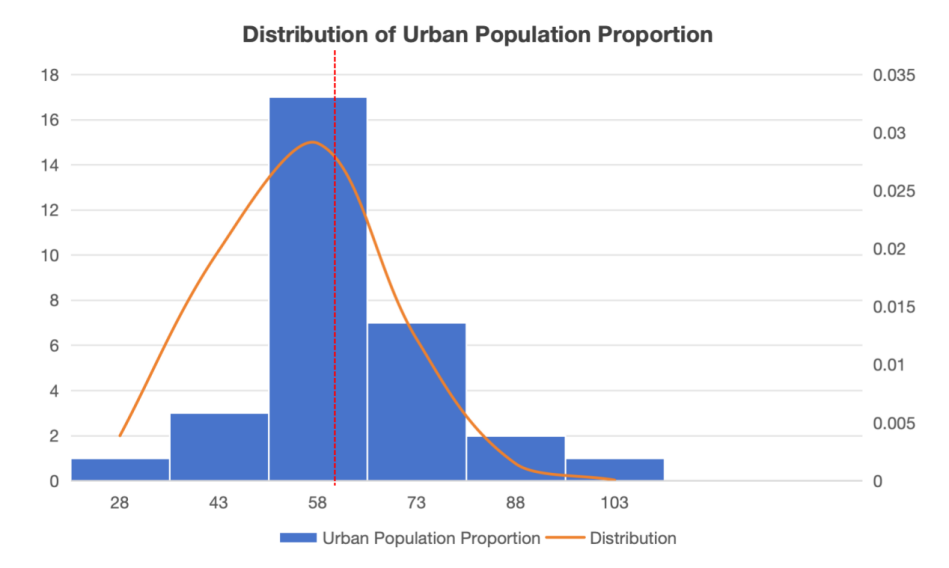
Through the urban-rural classification, this paper split 31 provinces in China into urban and rural, where the urban region includes 15 provinces, and the rural region includes 16 provinces.
4.2. Income gap
The Income gap between urban and rural presents the dependent variable in this paper. Based on the classification above, we calculate average urban per capita disposable income (CNY) and average rural per capita disposable income (CNY) separately from 2005 to 2022. Then we used average urban per capita disposable income divided by average rural per capita disposable income to compare the change in income gap over time.
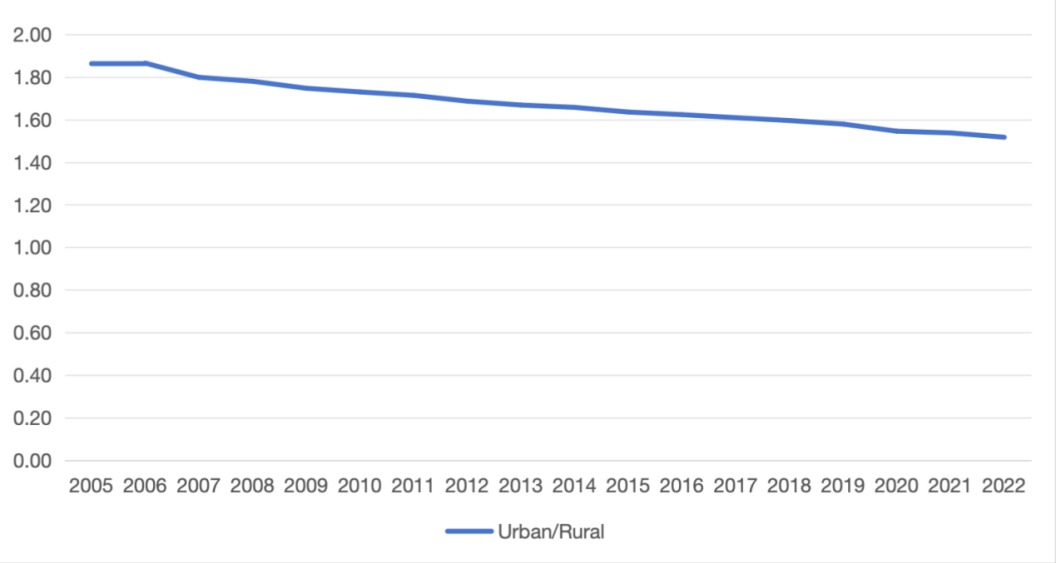
As shown in Figure 2, the income gap between urban and rural saw a decreasing trend. Although the per capita income in urban has always been higher than that in rural, which was approximately 1.9 times that in rural areas in 2005, the differences in urban and rural income are getting smaller and smaller. In 2013 and 2016, the selective two-child policy and the universal two-child policy were enacted. Subsequently, the three-child policy was implemented in 2021. With changes and advancements in policies, the income gap between urban and rural reduces. There is a climbing trend in the per capita income in rural from 2005 to 2022, and it maintains increasing to have a larger share. The per capita income in urban only 1.5 times of that in the rural area in 2022. As a result, the distribution of income in urban and rural areas has equalized over the past 20 years.
4.3. Birth rate
The birth rate is a demographic measure that represents the number of live births in a population over a specific period. In our paper, the birth rate is expressed as the number of births in China per 1,000 people per year. We use millesimal (‰) as the unit of data. We found that the annual birth rate changes with the update of China's fertility policy. Therefore, the birth rate can represent the implementation of the fertility policy. We focus on analyzing the relationship between the birth rate and the urban-rural income gap in each year to measure the impact of family planning on the urban-rural income gap.
Since the annual fertility rates of each province were not published in the Statistical Yearbook of the National Bureau of Statistics of China until 2000, this paper collects and analyzes data from 2005 to 2022. The birth rate, migration rate, and urban-rural income gap before this period are mainly analyzed based on past literature.
|
Year |
Average Birth Rate (Urban) (‰) |
Average Birth Rate (Rural) (‰) |
Birth Rate Gap (Rural-Urban) (‰) |
|
2005 |
9.64 |
13.63 |
3.99 |
|
2006 |
9.56 |
13.37 |
3.80 |
|
2007 |
9.86 |
13.28 |
3.42 |
|
2008 |
9.75 |
13.20 |
3.45 |
|
2009 |
9.70 |
13.17 |
3.48 |
|
2010 |
9.56 |
13.14 |
3.57 |
|
2011 |
9.37 |
12.90 |
3.53 |
|
2012 |
9.92 |
13.02 |
3.10 |
|
2013 |
9.58 |
13.05 |
3.47 |
|
2014 |
10.17 |
13.19 |
3.01 |
|
2015 |
9.41 |
13.01 |
3.60 |
|
2016 |
10.43 |
13.26 |
2.83 |
|
2017 |
10.70 |
13.64 |
2.94 |
|
2018 |
9.73 |
12.57 |
2.84 |
|
2019 |
9.31 |
11.89 |
2.58 |
|
2020 |
7.20 |
10.13 |
2.93 |
|
2021 |
6.46 |
9.16 |
2.71 |
|
2022 |
5.82 |
8.56 |
2.74 |
We calculated the average birth rate for all urban and rural provinces (see Table 1). The birth rate gap reflects the relative difference between rural and urban birth rates, which is crucial for understanding how population growth dynamics might influence the economy. Analyzing this gap in relation to the income gap helps to capture how the relative population changes relate to income changes. Moreover, compared to analyzing the average birth rates of rural and urban areas separately with the income gap, considering only the birth gap and income gap simplifies the model by reducing the number of variables. Birth rate gap between rural and urban provinces is:
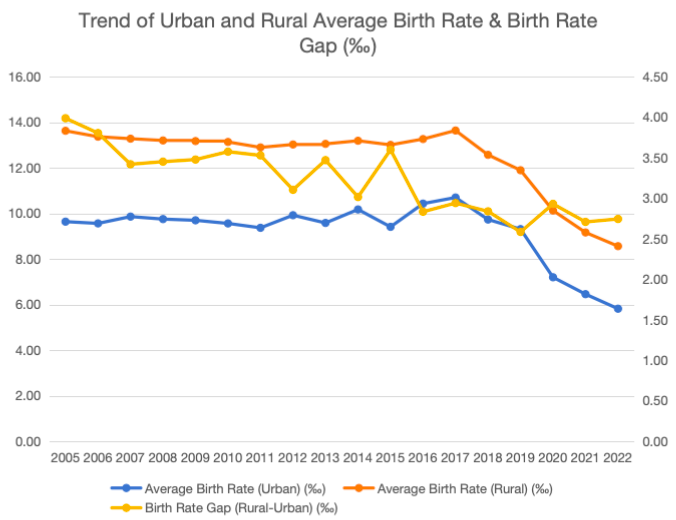
In Figure 3, both rural average birth rate and urban average birth rate are positive during 2005-2022. The rural average birth rate is greater than the urban average birth rate. Therefore, we utilized the rural birth rate - urban birth rate to calculate the birth rate gap to ensure that the birth rate gap is positive for easy observation. The birth rate gap decreases over the years generally.
4.4. Migration rate
We see the population migration rate in China as a potential factor affecting the urban-rural income gap. A mobile population can bring laborers with a variety of skills to both urban and rural areas. We suspected that as migration rate increases across years, urban-rural areas will equalize, leading to a narrowing of the urban-rural income gap.
The data on migrant population is not disclosed by the National Bureau of Statistics of China. The population growth rate of each province is affected by birth and death rates, making it an inaccurate reflection of population movement. Therefore, it cannot be directly used as a migration rate. However, through calculation, we can estimate the migration rate. We collected the publicly available data and calculated the estimated migration rates of urban and rural provinces through four steps.
The first step is calculating the population of each province after eliminating the effects of birth and death rate (X) as equation (2):
After removing the interference of births and deaths, the change in the X value is purely caused by immigration in and out of the province. Unfortunately, the natural growth rate for 2020 is not available. We assigned a weight of 50% to 2019 and 2021 respectively, and used their weighted average to replace the missing natural growth rate for 2020.
In the second step, we derived the migration rate, which is defined as the change in the population of each province after eliminating the effects of birth and death rate (△X):
In the third step, the 31 provinces (areas) were split into 15 rural provinces (areas) and 16 urban provinces according to the method introduced in the urban-rural classification section. We computed the average migration rate in urban provinces and the average migration rate in urban provinces, as shown in Table 2. Classifying the data into these two categories allows us to directly compare the differences in migration rates between urban and rural provinces.
Finally, we quantified the average migration rate gap by:
|
Year |
Migration Rate (Urban ) (‰) |
Migration Rate(Rural) (‰) |
Migration Gap (Urban-Rural) (‰) |
|
2005 |
7.00 |
-3.79 |
10.80 |
|
2006 |
13.49 |
6.70 |
6.79 |
|
2007 |
11.94 |
5.54 |
6.39 |
|
2008 |
17.73 |
7.34 |
10.39 |
|
2009 |
13.43 |
5.61 |
7.82 |
|
2010 |
20.98 |
2.20 |
18.78 |
|
2011 |
17.04 |
11.17 |
5.87 |
|
2012 |
5.22 |
6.62 |
-1.41 |
|
2013 |
11.37 |
5.01 |
6.37 |
|
2014 |
2.89 |
6.31 |
-3.42 |
|
2015 |
8.89 |
7.37 |
1.52 |
|
2016 |
-6.61 |
5.93 |
-12.54 |
|
2017 |
-0.61 |
4.63 |
-5.24 |
|
2018 |
11.20 |
15.89 |
-4.70 |
|
2019 |
4.54 |
13.75 |
-9.21 |
|
2020 |
16.72 |
24.21 |
-7.48 |
|
2021 |
18.20 |
18.79 |
-0.59 |
|
2022 |
7.29 |
9.86 |
-2.57 |
Note: Due to the absence of natural growth rate data for 2020, the migration rate (urban), migration rate (rural), and migration rate gap for 2020 and 2021 (underlined year) is based on estimates.
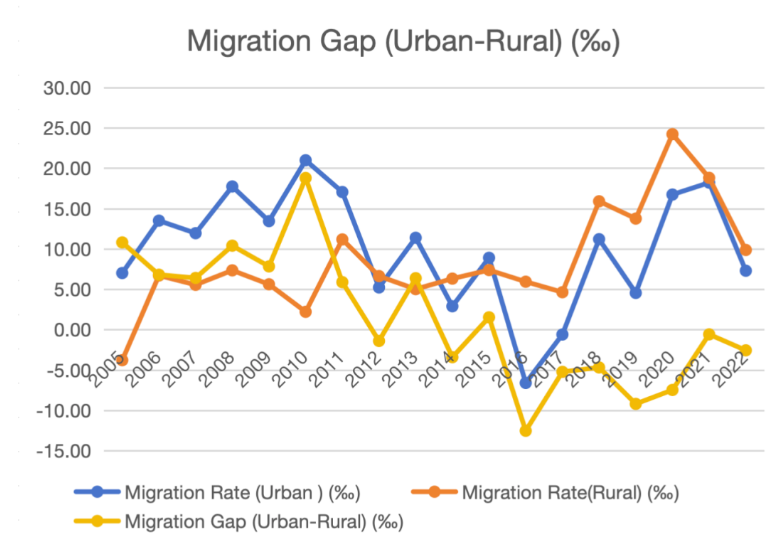
Note: Due to the absence of natural growth rate data for 2020, the migration rate gap for 2020 and 2021 is based on estimates.
Figure 4 illustrates that the migration rate in urban provinces initially declined before rising again, whereas the migration rate in rural provinces generally exhibited an upward trend. Between 2005 and 2015, the migration rate in urban provinces was higher than that in rural provinces. However, from 2015 to 2022, the migration rate in rural provinces surpassed that of urban provinces. The gap in migration rates has generally decreased and shifted from positive to negative. Therefore, we can conclude that between 2005 and 2015, a larger proportion of the population in China was inclined to migrate to urban provinces compared to rural provinces. However, over time, there has been a shift towards greater migration to rural provinces. After 2015, the trend of migrating to rural provinces significantly surpassed that of migrating to urban provinces. As a result, the urban-rural migration gap has decreased and reversed from positive to negative.
4.5. Trends in Urban and rural average migration rates and migration rate gap
To assess whether the birth rate and migration rate influence the decline in the urban-rural income gap, we first need to gather the migration rate gap (‰), birth rate gap (‰), and urban-rural income gap.
|
Urban-Rural |
Rural-Urban |
Urban/Rural |
|
|
Year |
Migration Rate Gap(‰) |
Birth Rate Gap (‰) |
Income Gap |
|
2005 |
10.80 |
3.99 |
1.85 |
|
2006 |
6.79 |
3.80 |
1.85 |
|
2007 |
6.39 |
3.42 |
1.79 |
|
2008 |
10.39 |
3.45 |
1.79 |
|
2009 |
7.82 |
3.48 |
1.75 |
|
2010 |
18.78 |
3.57 |
1.72 |
|
2011 |
5.87 |
3.53 |
1.72 |
|
2012 |
-1.41 |
3.10 |
1.69 |
|
2013 |
6.37 |
3.47 |
1.67 |
|
2014 |
-3.42 |
3.01 |
1.67 |
|
2015 |
1.52 |
3.60 |
1.64 |
|
2016 |
-12.54 |
2.83 |
1.61 |
|
2017 |
-5.24 |
2.94 |
1.61 |
|
2018 |
-4.70 |
2.84 |
1.59 |
|
2019 |
-9.21 |
2.58 |
1.59 |
|
2020 |
-7.48 |
2.93 |
1.54 |
|
2021 |
-0.59 |
2.71 |
1.54 |
|
2022 |
-2.57 |
2.74 |
1.52 |
Note: Due to the absence of natural growth rate data for 2020, the migration rate gap for 2020 and 2021 (underlined data) is based on estimates.
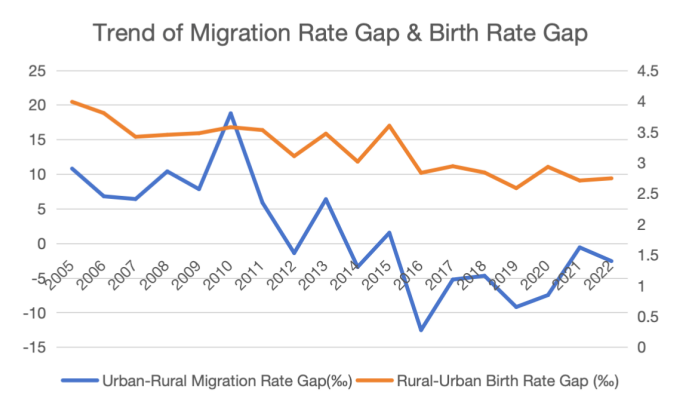
Note: Due to the absence of natural growth rate data for 2020, the migration rate gap for 2020 and 2021 is based on estimates.
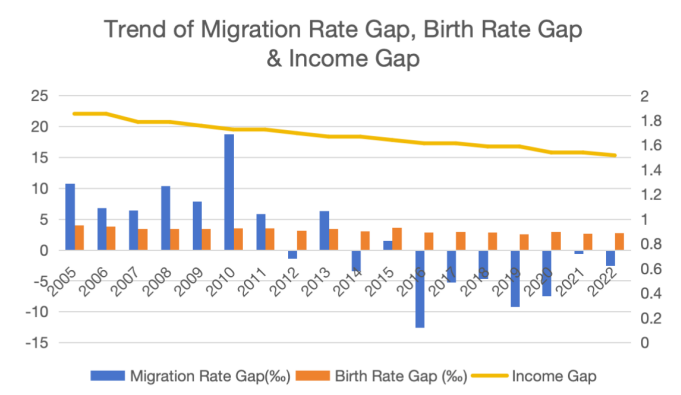
Note: Due to the absence of natural growth rate data for 2020, the migration rate gap for 2020 and 2021 is based on estimates.
Based on Table 3, Figure 5, and Figure 6, our analysis reveals that as the migration rate gap and the birth rate gap decrease, the income gap also diminishes. We speculated a positive correlation between the migration rate gap, the birth rate gap, and the income gap. That is, the year-by-year reduction in the migration rate gap and the birth rate gap contributes to the narrowing of the income gap.
5. Regression analysis
To validate this hypothesis that the migration rate gap and the birth rate gap contributes to changes in the income gap, we developed a regression model:
Where the dependent variable is the income gap. The independent variables are the migration rate gap and the birth rate gap.
Based on equation 4, we conducted a regression analysis and obtained the results in Table 4:
|
Explanatory Variable |
Dependent variable: Income Gap ( 1 ) |
|
Migration Rate Gap |
0.0007 |
|
(0.0029) |
|
|
Birth Rate Gap |
0.208*** |
|
(3.699) |
|
|
Constant |
1.0028 |
|
(0.178) |
|
|
Observations |
18 |
|
0.722 |
Note: Standard errors in the parentheses. Significantly different from zero at 90% (*), 95% (**), 99% (***) confidence. Due to the absence of natural growth rate data for 2020, the migration rate gap for 2020 and 2021 (underlined data) is based on estimates.
Thus, we derive the new regression equation 5:
Table 4 shows the estimated relationship between the migration rate, birth rate gap, and income gap. Column (1) shows that there is a significantly positive correlation between birth rate and income gap (t-stat = 3.699; p-value = 0.00215), while migration rate does not have a statistically significant effect on the income gap in the context of the model (t-stat = 0.236; p-value = 0.816). The estimated coefficient of birth rate is 0.208, meaning that, all else constant, a 1‰ increase in birth rate is associated, on average, with a 0.208% increase in the income gap.
6. Conclusion
Family planning policy has played an important role in the past fifty years. After the one-child policy was implemented in 1979, fertility rates continued to decline [15]. Other issues arising from the one-child policy, such as the aging population and income inequality, are increasingly becoming concerns. However, Zhang also suggests that the one-child policy may have had a small short-term effect on fertility around 1979 but little or no additional long-term effect.[15] As society develops, relatively lenient family planning policies are implemented in the 21st century. The two-child policy and the three-child policy encourage childbirth and bring benefits, including a large reduction in abortions of unapproved pregnancies, virtual elimination of the problem of unregistered children, and a more normal sex ratio [16].
Based on the multiple regression model, the findings in this paper suggest that the family planning policy does affect urban-rural income inequality. More specifically, a relatively lenient family planning policy narrows down the income gap between urban and rural. With the regression analysis, migration has a negligible impact on urban-rural income inequality, providing evidence of the greater effects of the birth rate gap on income distribution in urban and rural. As the birth rate gap between urban and rural decreases by 1 millesimal point, the income gap reduces by 0.208 units. Therefore, a relatively lenient family planning policy is suggested to reduce income inequality.
The results of this paper reveal the potential impact of the family planning policy on income inequality, which can serve as a reference for family-related issues. Income inequality is an emerging theme across the world, Ooms finds there is also a widening gap between the wealth and incomes of those at the top and those seat the bottom in America by collecting data [17]. We can expect a continuing focus on how income inequality between urban and rural leads to family poverty and the care needs of the elderly population. Ooms believes that the elderly is poised to become the most important, complicated, and most visible issue that will and should dominate family policy for a long time to come [17]. Therefore, the results provide a theoretical basis and space for further research on family-related issues caused by the family planning policy.
Acknowledgement
Xiaoyu Fei, Xintong Li, Yuxin Song, and Yifei Wang contributed equally to this work and should be considered co-first authors.
References
[1]. Lu, J. H. (1999). Review and Prospect of Research on Population-Economy Relationships in China since Reform and Opening-up. Population & Economics, 06, 1-9.
[2]. Lai, D. S. (2001). Family planning and urban-rural income gap. Chinese Journal of Population Science, 03.
[3]. Xie, Y. , Zhou, X. (2014). Income inequality in today’s China. PNAS, 19, 6928-6933.
[4]. Su, B. , Heshmati, A. (2013). Analysis of the Determinants of Income and Income Gap between Urban and Rural China. IZA Discussion Paper, 7162, 1-26.
[5]. Yu, Y. W. , Fan, Y. , Yi, J. J. (2020). The One-Child Policy Amplifies Economic Inequality across Generations in China. IZA Discussion Paper, 13617, 1-19.
[6]. Wang, C. T. (2012). History of the Chinese Family Planning program: 1970–2010. Science Direct, 85(6), 563-569.
[7]. State Council (PRC). (2016). Decision of the Central Committee of the Communist Party of China and the State Council on Implementing the Comprehensive Two-Child Policy and Reforming and Improving the Management of Family Planning Services.
[8]. State Council (PRC). (2021). Decision of the Central Committee of the Communist Party of China and the State Council (PRC). on Optimizing Fertility Policy and Promoting Long-term Balanced Population Development.
[9]. Li, S. , Terry, S. , & Finn T. (2020). Income inequality in China: development, transformation and policy. Journal of Beijing Technology and Business University (Social Sciences), 35(4), 21-31.
[10]. Wu, Q. F. , Su, Q. (2018). How does the family planning policy affect the urban-rural income gap: an empirical analysis based on CFPS data. Journal of Guizhou University of Finance and Economics, 04, 1-11.
[11]. Li, S. , Zhao, R. W. (1999). Restudy on the Income Distribution of Chinese Residents. China Academic Journal Electronic Publishing House, 04, 3-16.
[12]. Chen, B. K. , Lin, Y. F. (2013). Development strategy, urbanization and China’s urban-rural income gap. Social Sciences in China, 35(1), 5-20.
[13]. Qin, B. , & Zhang, Y. (2014). Note on urbanization in China: Urban definitions and census data. China Economic Review, 30, 495-502.
[14]. Wu, Y. , Liu, Y. , Li, Y. (2018). Spatio-temporal coupling of demographic-landscape urbanization and its driving forces in China. Acta Geographica Sinica, 73(10), 1865-1879.
[15]. Zhang, J. (2017). The Evolution of China's One-Child Policy and Its Effects on Family Outcomes. Journal of Economic Perspectives, 31(1), 141–60.
[16]. Zeng, Y. , Hesketh, T. (2016). The effects of China's universal two-child policy. The Lancet, 388, 1930-1938.
[17]. Ooms, T. (2019). The Evolution of Family Policy: Lessons Learned, Challenges, and Hopes for the Future. Journal of Family Theory & Review, 11(1), 18-38.
Cite this article
Fei,X.;Li,X.;Song,Y.;Wang,Y. (2025). The Impact of Family Planning Policy in China on Urban-rural Income Inequality. Lecture Notes in Education Psychology and Public Media,101,138-151.
Data availability
The datasets used and/or analyzed during the current study will be available from the authors upon reasonable request.
Disclaimer/Publisher's Note
The statements, opinions and data contained in all publications are solely those of the individual author(s) and contributor(s) and not of EWA Publishing and/or the editor(s). EWA Publishing and/or the editor(s) disclaim responsibility for any injury to people or property resulting from any ideas, methods, instructions or products referred to in the content.
About volume
Volume title: Proceedings of the 2nd International Conference on Global Politics and Socio-Humanities
© 2024 by the author(s). Licensee EWA Publishing, Oxford, UK. This article is an open access article distributed under the terms and
conditions of the Creative Commons Attribution (CC BY) license. Authors who
publish this series agree to the following terms:
1. Authors retain copyright and grant the series right of first publication with the work simultaneously licensed under a Creative Commons
Attribution License that allows others to share the work with an acknowledgment of the work's authorship and initial publication in this
series.
2. Authors are able to enter into separate, additional contractual arrangements for the non-exclusive distribution of the series's published
version of the work (e.g., post it to an institutional repository or publish it in a book), with an acknowledgment of its initial
publication in this series.
3. Authors are permitted and encouraged to post their work online (e.g., in institutional repositories or on their website) prior to and
during the submission process, as it can lead to productive exchanges, as well as earlier and greater citation of published work (See
Open access policy for details).
References
[1]. Lu, J. H. (1999). Review and Prospect of Research on Population-Economy Relationships in China since Reform and Opening-up. Population & Economics, 06, 1-9.
[2]. Lai, D. S. (2001). Family planning and urban-rural income gap. Chinese Journal of Population Science, 03.
[3]. Xie, Y. , Zhou, X. (2014). Income inequality in today’s China. PNAS, 19, 6928-6933.
[4]. Su, B. , Heshmati, A. (2013). Analysis of the Determinants of Income and Income Gap between Urban and Rural China. IZA Discussion Paper, 7162, 1-26.
[5]. Yu, Y. W. , Fan, Y. , Yi, J. J. (2020). The One-Child Policy Amplifies Economic Inequality across Generations in China. IZA Discussion Paper, 13617, 1-19.
[6]. Wang, C. T. (2012). History of the Chinese Family Planning program: 1970–2010. Science Direct, 85(6), 563-569.
[7]. State Council (PRC). (2016). Decision of the Central Committee of the Communist Party of China and the State Council on Implementing the Comprehensive Two-Child Policy and Reforming and Improving the Management of Family Planning Services.
[8]. State Council (PRC). (2021). Decision of the Central Committee of the Communist Party of China and the State Council (PRC). on Optimizing Fertility Policy and Promoting Long-term Balanced Population Development.
[9]. Li, S. , Terry, S. , & Finn T. (2020). Income inequality in China: development, transformation and policy. Journal of Beijing Technology and Business University (Social Sciences), 35(4), 21-31.
[10]. Wu, Q. F. , Su, Q. (2018). How does the family planning policy affect the urban-rural income gap: an empirical analysis based on CFPS data. Journal of Guizhou University of Finance and Economics, 04, 1-11.
[11]. Li, S. , Zhao, R. W. (1999). Restudy on the Income Distribution of Chinese Residents. China Academic Journal Electronic Publishing House, 04, 3-16.
[12]. Chen, B. K. , Lin, Y. F. (2013). Development strategy, urbanization and China’s urban-rural income gap. Social Sciences in China, 35(1), 5-20.
[13]. Qin, B. , & Zhang, Y. (2014). Note on urbanization in China: Urban definitions and census data. China Economic Review, 30, 495-502.
[14]. Wu, Y. , Liu, Y. , Li, Y. (2018). Spatio-temporal coupling of demographic-landscape urbanization and its driving forces in China. Acta Geographica Sinica, 73(10), 1865-1879.
[15]. Zhang, J. (2017). The Evolution of China's One-Child Policy and Its Effects on Family Outcomes. Journal of Economic Perspectives, 31(1), 141–60.
[16]. Zeng, Y. , Hesketh, T. (2016). The effects of China's universal two-child policy. The Lancet, 388, 1930-1938.
[17]. Ooms, T. (2019). The Evolution of Family Policy: Lessons Learned, Challenges, and Hopes for the Future. Journal of Family Theory & Review, 11(1), 18-38.





